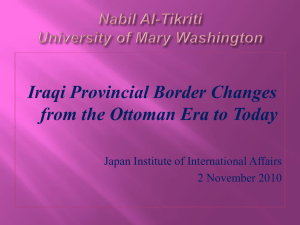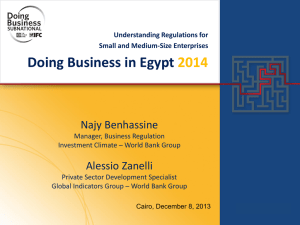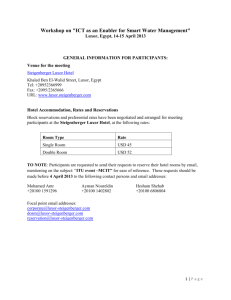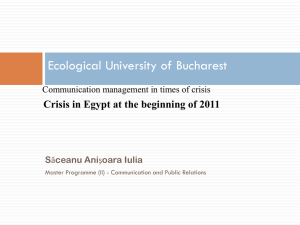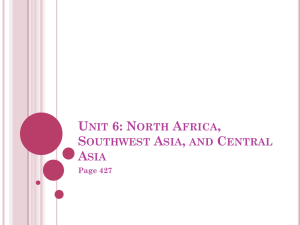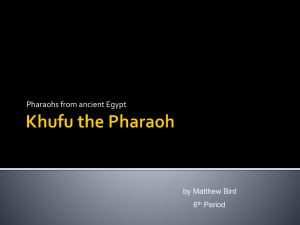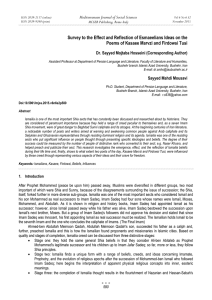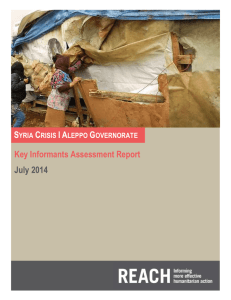Shelter programmes and City Development
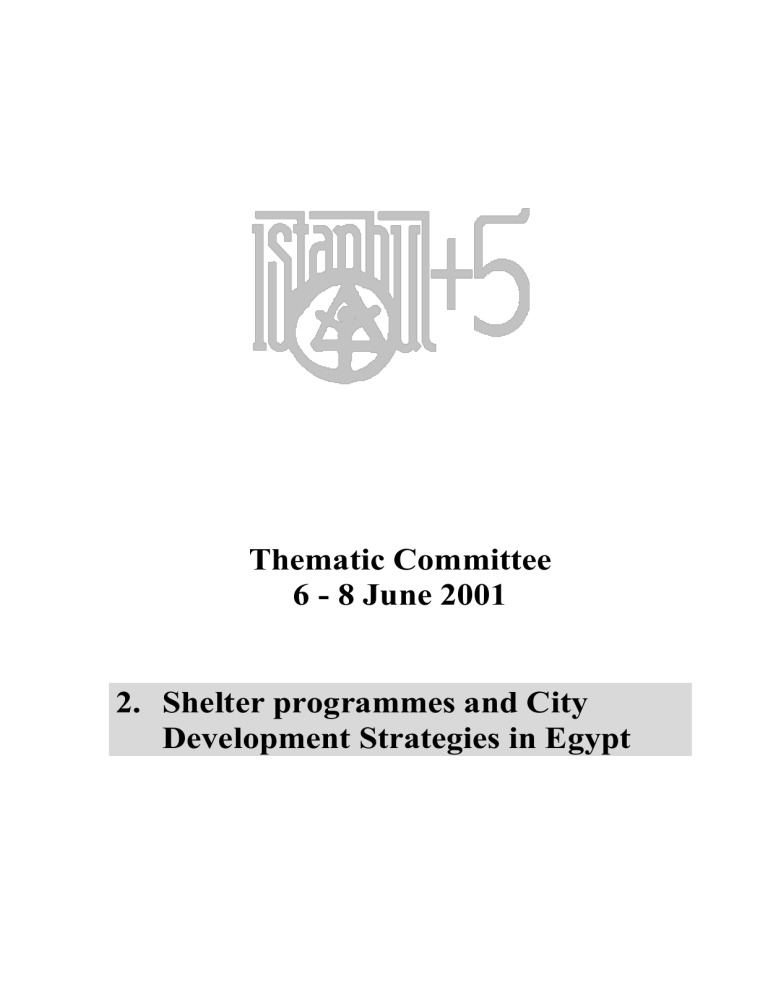
Thematic Committee
6 - 8 June 2001
2. Shelter programmes and City
Development Strategies in Egypt
Shelter programmes and City Development Strategies in Egypt
By the Ministry of Housing, Utilities and Urban Communities
Arab Republic of Egypt
INTRODUCTION
The purpose of this paper is to outline the Government of Egypt (GOE) efforts for presentation at the United Nations General Assembly at its June 2001 special session
(Istanbul+5). Its focus is on two sub-themes and key items of the Habitat Agenda, namely:
Shelter and City Development Strategies. It is understood that this session has two objectives. First is to review and to assess the implementation of the Habitat Agenda
(Istanbul 1996). Second is to exchange information and to learn lessons derived from the implementation in various countries.
Since 1996, GOE efforts, regarding shelter for all, can be illustrated using two cases of projects, namely: “Mubarak Youth Housing Project” and “The Future Housing Project”, each of which is aiming at constructing 70,000 dwelling units. GOE efforts are not limited to secure houses for disadvantaged households but extended the task to improve their living environment/services/standards to be healthy and productive. This can be illustrated by presenting three cases of urban development projects, namely: “Manshiet Nasser
Upgrading Project”, “The Comprehensive Development for the City of Luxor”, and
“Sustainable Ismailia Governorate Project”.
A. Shelter For All in EGYPT, 1996 – 2001
Government of Egypt integrated the rights of low-income/disadvantaged groups to appropriate shelter and affordable housing in its economic reform program, which began in the early 1990s. This integration has been made on the basis of an indigenous cultural value of “Eltakaful El-Egtemaie”. This value means the responsibility of capable/wealthy groups towards disadvantaged/poor ones, the result of which is social solidarity. This value can be achieved either through direct donations or cross–subsidy mechanisms. This integration is illustrated here through a presentation of the following two projects.
A.1. “Mubarak Youth Housing Project”
“Mubarak Youth Housing Project” had been started in 1996. Its aim was to provide 70,000 affordable dwelling units, in a healthy and productive residential environment. The beneficiaries were the Youth who belong to the disadvantaged/low-income groups. The project was completed in December 2000, and its units were distributed in 15 new cities.
The project was formulated to offer a wide range of floor spaces (100-70-63 sq. m.) in order to satisfy the needs of different household sizes. The designs of both dwellings and layouts had been chosen through national architectural competitions. The chosen designs fulfill the targeted requirements of gross residential density (120 persons/acre) and a maximum height (5 floors) to allow for ample green areas, parking spaces, and various social services.
The project cost was about L.E. 2.75 billion. Of this amount, the state cross-subsidized nearly 40% from the sales of high-income residential areas and dwellings in both new cities and resorts. This is in exclusion of price of serviced land, which is, also, financed from
2
these revenues. In addition, the State offered L.E. 1 billion in subsidized credit in the form of soft loans of L.E. 15000 per unit, payable over 40 years at 5% interest rate. The dwelling units were allocated according to objective criteria, which had been investigated to ensure the legibility of beneficiaries.
After the successful completion, the State is developing, now, new mechanisms to replicate the project in a larger scale during the next five years. The objective of these developments is to mobilize more resources from capable/wealthy groups to support the Youth of disadvantaged groups, e.g. participation of businessmen, contractors, real estates companies, financial institutions (especially private ones).
A.2. “The Future Housing Project”.
In February 1998, her Excellency Mrs. Susan Mubarak called for a new social contract between the capable/wealthy and disadvantaged/poor groups of the society as regards housing. In March1998, a non-governmental organization named “Gameyet el Mostaqbal”
(Society of the Future) was especially established to supervise implementation of the project. The board of this NGO is composed of businessmen in real estate, manufacturing and construction. Thus, “The Future Housing Project” has been launched in an innovative way that builds up social solidarity and partnership.
The project is designed to construct 70,000 dwelling units with an area of 63 sq. m. /unit, at an estimated total cost of L.E 2.1 billion, without the cost of land. This number of units will be implemented on three phases over a period of 6 years (15000 in the first, 25000 in the second, and 20000 units in the third phase). The private sector responded quickly, as investors/wealthy people pledged to raise L.E. 1 billion over 6 years, thus covering 50% of the total cost. The state is to cover the other half of this cost, in addition to the supply of land with infrastructure and basic services. The project offers a subsidized credit in the form of soft loans of L.E. 14000 per unit, payable over 40 years at 5% interest rate.
The first phase had been started in May 1998 and was completed after two years. The units of this phase were replicated in 15 new cities in Egypt. The units were allocated according to objective criteria and through official investigations to ensure the eligibility of each beneficiary. This project has received the Council of Arab Ministers for Housing and
Reconstruction AWARD in the year 2000 for its innovative approach that integrates architectural, planning, social, economic, cultural, technological, and environmental dimensions.
B. City Development Strategies.
B.1. “Manshiet Nasser Upgrading Project”
.
Manshiet Nasser is the largest squatter/informal area in Cairo. It is located on the East of the Autostrad Road, close to Fatimid Cairo. There are 350,000 persons living in this area on about 850 acres with a gross residential density more than 400 persons/acre. The area is suffering from poor living qualities, inadequate services, lack of infrastructure, and deteriorated environmental conditions. The site is characterized by sharp contour variations ranging between +56 and +200 meters.
Major characteristics of the inhabitants outlined through a sociological study conducted in
1998. The results indicate that 60% of housing units are 50 to 80 sq. m. in area, while 15%
3
are less than 50 sq. m. and 25% are over 80 sq. m.; the labor force are craftsmen, administrative and services workers, 20% in private business and 15% in different jobs related to garbage collection, sorting or recycling.
“Manshiet Nasser Project” is made as a pilot project to be replicated in upgrading other informal areas. It is a pilot for applying the rehabilitation and replacement strategy in informal settlements, putting into practice the concept of “renewal and replacement”. This application is done through the development of a proximate desert land (first phase/extension area) to accommodate the first group of residents relocated from the first part. Consequently, the evacuated part was planned, developed and occupied by a second group of residents, and then planning and developing the second evacuated part, and so on until the whole area is upgraded.
The master plan of the whole area of Manshiet Nasser (including the extension area) is made to preserve existing buildings with good conditions (whenever possible), to satisfy planning norms, to integrate local road network with the Autostrad Road and the nearby main routes, and with Fatimid Cairo.
The project aims at stimulating the contribution and activating the participation of all interested parties (especially the 25 NGOs existing in the area) as a tool to achieve sustainable urban development. The participation is accelerated through formulating a collective local institution in which all stakeholders are members. Therefore, an on site coordination office for stakeholders’ representatives has been found. This office eases and facilitates an effective dialogue among different stakeholders (public, private, residents,
NGOs, etc).
Governmental partners (institutions) contributed by constructing 4 schools, a hospital, 2500 dwelling units (out of 14000 units) supplied with services and infrastructure, providing the whole area with infrastructure, and greening it. An official committee is formulated in order to supervise and to follow up implementation of their contributions.
Private sector is responsible for establishing small-scale projects, e.g. personal services, commercial facilities, handicraft units and small industries on the serviced land given to them for free. The multiplier effect of these projects contributes to job creation and poverty eradication.
The 25 existing NGOs have been brought together in order to communicate and to know each other, and to find a way to cooperate and to complement. They have been oriented to include other interests in their agenda, e.g. women activities, youth productivity, environmental awareness, and residents’ orientation to live in harmony with their new urban setting.
B. 2. “The Comprehensive Development for the City of Luxor Project”.
Luxor, Egypt is the world’s most treasured antiquities sites. It is on the exclusive UNESCO
World Heritage Site List, as one of the only 560 natural and cultural sites worldwide.
In 1989, the city of Luxor was given a special status by a Presidential decree creating the
Higher Council for Luxor City (HCLC), modifying its boundaries, granting jurisdictional authority given to a Governorate. Luxor area had a population of 360,000 in 1996. Luxor city is the major population center in this antiquities area with about 175,000 residents at
4
that time. It is located 635 km. South of Cairo, stretched approximately 5 km. North – south and 1.5 km. East–west. Tourism and related services employ about 42% of the total labor force. Agriculture is the second employer (29%). Industrial production is insignificant
(6.3%) and focuses on tourism–related products (e.g. rugs, carpets, papyrus, alabaster).
City of Luxor is facing many problems. Urban sprawl threatens historical sites as well as agricultural land. Many parts of the city is lacking infrastructure. Cairo–Aswan railway track generates vibrations that threaten the safety of temples. Raising underground water table poses a similar threat. Uncontrolled cruise traffic gave raise to serious environmental problems, such as sewerage and other discharges from the vessels. Rapid and uncontrolled growth of cruise travel has brought serious traffic and environmental troubles. Luxor needs to maintain its viability as a desired tourist destination, and accommodate the rapid expansion of tourism and agriculture.
Ministry of Housing, Utilities and Urban Communities has extended technical assistance
(together with UNDP and Habitat) to the Higher Council for Luxor City to formulate and implement a strategic development plan for sustainable development of Luxor. The project will create an efficient framework for guiding development, attracting investment from the private sector and international institutions for priority projects; establish a realistic program to deal with the deterioration of the monuments and upgrade the surrounding sites; produce physical plans and feasibility studies for two new settlements (one of them is a residential city and the other is an hotel zone) in order to attract urban growth away from the existing resources and to facilitate future developments of tourism and related industries; involve the local community in the development process and encourage the involvement of private associations in linked activities; create a diversified employment base in greater Luxor to increase the stability and sustainability of its economy; improve the standard of living especially the disadvantaged groups through the implementation of
Sustainable Livelihood Approach (SLA).
Six priority projects (out of 40 ones) have been selected, namely: 1) excavation and restoration of the road of Sphinxes in Luxor City; 2) development and transform Luxor
City to be an Open Museum; 3) development of a new residential area (New Luxor City);
4) development of an hotel zone at El-Toad; 5) providing the new area with infrastructure;
6) introduce and spread high-value agriculture in Luxor area.
SLA in Luxor entails activities directed to link macro with micro levels of both investment and administration in order to enhance governance and stimulate economic development. It is intended to benefit youth/women/disadvantaged groups in specific issues of job creation and poverty eradication. In order to achieve its intentions, SLA program came out with five projects, namely: 1) incubation center for small industries in Luxor; 2) Technical Access
Community Center (TACC); 3) the implementation of five community action plans through
NGOs; 4) initiating a Micro Start Credit Program (MSCP); and 5) start up skills building programs for disadvantaged groups.
CDLC project is using urban planning and management techniques developed by the
Sustainable Cities Programme (SCP), particularly consultations and working groups as a participatory interface between the international consulting consortium preparing the development plan and the interested parties. The working groups have assessed the current situation, highlighting major issues, problems, development needs and deficiencies.
5
Furthermore, the working groups provide inputs to the consortium and participate in the decision–making process regarding proposals.
The CDCL will have an executive unit, which will guide the project through the major activities. The CDCL Project is proposing that the structure will take the form of a board of directors. This board will be sponsored by the first lady, Mrs. Suzan Mubarak and headed by the Prime Minister as its chairperson and with representatives of concerned parties as well as the Governor of Luxor. This board of directors will maintain a clear vision for the development of Luxor, and make sure that implementation of all the individual investment project is done in accordance with the vision as stated by the CDCL. This board will not supersede the role of the City Council of Luxor, but guide the activities in a manner that enables interministerial coordination.
Through the participatory approaches used, including city consultations and Thematic working groups, the project has been able to ensure involvement of various parties in the comprehensive development planning process. The comprehensive development plan has been completed and the implementation stage is under way. The CDCL project strengthened the HCL institutional capacity, as it is the implementation agency of the project, and built the capacities of human resources of the locals, through a number of training courses and workshops. The project will organize a donor round table to fund the plan.
B. 3. “Sustainable Ismailia Governorate Project” (SIGP).
Ismailia Governorate area is 4480 sq. km. Approximately. It is located along the west and east bank of the Suez Canal. It comprises five cities (Markaz). According to 1996 census, total population is about 700 thousands persons. Ismailia city is the capital of the
Governorate with a population of about 221 thousands persons.
Ismailia Governorate has a diversified economic base. Its climate and soil conditions promote the Governorate as Egypt’s significant fruits and vegetables producer. Its potentials for hosting recreational and tourist establishments are evident along the waterfront of Lake Timsah and Greater Bitter Lakes. Ismailia’s location as the hub–city for the canal region puts it at cross roads to Cairo, Suez, Port–said and Sinai. This location grants an attractive position for clean industries and exporting out–let for Egypt agricultural products. Also, the construction of El–Ferdan Bridge over the Suez Canal, the establishment of The Valley of Technology as well as El–Salam irrigation canal for land reclamation project will contribute greatly to the development of Ismailia Governorate.
The Governorate has common environmental economic problems, namely: the limited water resources characterized by low quality, lack of most human settlements to adequate waste water collection and treatment services, the small employment constrains inhabiting micro enterprises, entrepreneurs suffering from limited access to business management knowledge (mainly marketing and technology) and the fail in attracting large scale private business and capital. Lake Timsah and Great Bitter Lakes are subject to acute pollution threatening the tourism industry and fishing activities. There are conflicts between urban expansion and agricultural activities. Also, land reclamation projects are putting more demands on water resources and have environmental problems, particularly the increasing volume of drain water.
Following the success of “Sustainable Ismailia Project” (SIP-1) – which dealt only with
Ismailia City - the United Nations Centre for Human Settlements (Habitat), the United
6
Nations Development Programme (UNDP), the Danish International Development Agency
(DANIDA), Social Fund for Development (SFD), and the Governorate of Ismailia had agreed to replicate and to finance similar project to cover the entire Governorate. The project document of SIGP (or SIP-II) was signed in May 1997 and its activities have started in August 1997, and are being executed by the Ismailia Governorate, with UNCHS
(Habitat) as the cooperating agency.
The main objectives of the SIGP project were:
Strengthening the local capacity to plan, coordinate, and manage environmental development through applying the environmental planning and management approach (EPM).
Preparing long strategic development plans.
Preparing public investment project proposals to mobilize funds, which in turn create job opportunities.
Capacity building for different sectors of the society, including leaders, members of
NGOs and CBOs, women and youth has been given special attention.
Because one of the priorities raised by the city consultations was slum upgrading in which many disadvantaged groups are living, an application was submitted to the joint World Bank / UNCHS, Cities Alliance for additional funding to prepare feasibility studies for upgrading two pilot areas (El-Hallous and El-Bahtini).
Results can be summarized as follows: The environmental profiles of the Ismailia
Governorate and the four cities have been completed and training center rehabilitated, where project training activities are taking place. The training center, managed by an NGO, serves various sustainable development-training requirements within the Governorate. The environmental planning and management approach has been institutionalized as the
Governorate has established a sustainable development council (chaired by the Governor of
Ismailia) at the Governorate level, and other five committees for Sustainable Development at the city level. The Governorate has commenced work on activities of Cities-Alliance-
Funded project aiming at producing feasibility studies for slum upgrading (social and physical surveys already completed). The project is also developing a framework for replication at the national level with the Ministry of Local Development, as main focal point, together with other partners at the national level. Several projects were identified for each “Markaz” with a priority for two of them.
Other projects have benefited from the Ismailia experience, “The national Environmental
Action Plan Project“ (NEAP), in cooperation with Ministry of Environmental Affairs;
SIGP arranged a training workshop for heads of departments of environment in all
Governorate of Egypt. The workshop was held at the sustainable development center for training and capacity building where the trainees were trained on different leadership skills that were acquired through SIGP project, particularly EPM process.
The Canadian Egyptian International Fund selected the Association of Development and
Environment to be the implementing partner in Ismailia. So far the Canadian Egyptian
International Fund has financed four projects.
C. Lessons Learned.
A central lesson derived from the two housing projects is that city development efforts should be based on culturally relative values. This cultural relativism ensures a full support
7
and participation of all citizens. It also magnifies its effects through a general tendency for replication in other locations in the country or in the society.
International cooperation facilitates the adoption and the implementation of objectives and approaches of the Habitat Agenda. Consequently, this cooperation ought to be enhanced through increasing technical assistance and financial support. The effectiveness of this cooperation can be ensured through a deep understanding of the development needs and other cultural considerations of each country, especially developing ones. Mechanisms of such cooperation should be agreed upon, and implementation procedures ought to be value free.
City development projects illustrate the importance of building trust and maintaining support from the relevant political authorities in a SCP project. For the SCP / EPM process to succeed and to spread, the governmental partners need to adopt it – and commit their own resources.
The public sector agencies saw that the actions and projects developed in a participatory way through the SCP / EPM process offered an opportunity for more effective and sustainable development interventions than some of the more traditional centrally-planned projects. As a result, various Government bodies “picked up” proposals (many government officers were on the working group) and have contributed the majority of funds to the actions which have been implemented to date, although funds have continued to come from a variety (including private and public) of sources.
City development projects should perhaps put greater emphasis on awareness raising, training, and capacity building in the very early stages of project implementation, to go in parallel with issue identification and clarification. This awareness is needed, not only during implementation phase but also, thereafter to attain sustainability.
To raise awareness in city development projects, both of the general environmental situation and specific local environment issues, requires the use of professionally organized and systematic public information tools and methods. In particular, reaching different target audiences requires different approaches – and requires specialist expert and the budget lines necessary to properly finance public information activities.
Perhaps, some stakeholders may not be willing to cooperate or share information and some of them may not always be able to attend the group meetings. Therefore, careful selection of stakeholders, the explanation of the EPM process fully to and orientation them on their expected roles and inputs should be given big attention.
Project management, which provides consistent leadership, based on a sensitive understanding of the local area, an ability to build consensus and mobilize partners, and skills in negotiating cooperation and agreement has been a factor mentioned by nearly all persons with knowledge of the indicated projects. Equally important in the SIP case appears top have been the ability of project management to maintain a low profile, letting other organizations and actors take a lead - and take “ownership”.
One of the lessons is the need to get potential funding sources involved at an early stage in developing solutions to problems, and projects to implement those solutions.
8
It is worthy to indicate that three active, inspired, and highly qualified women direct the three city development projects presented above. It is evidence that Egypt is fully aware of and genuinely practicing gender equity.
9
